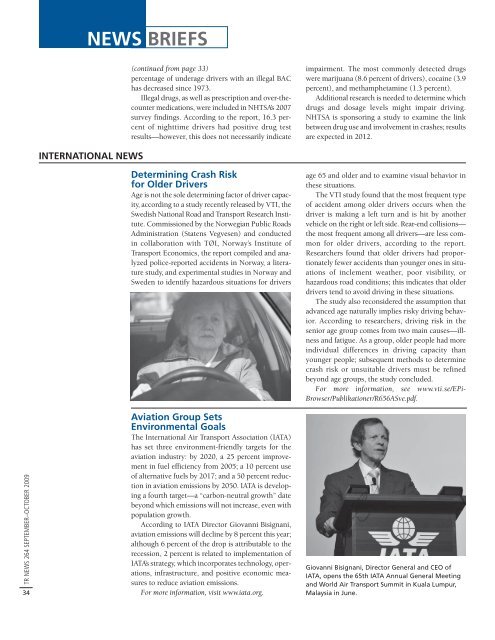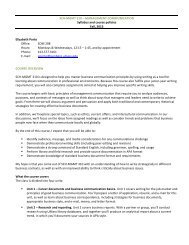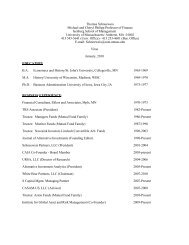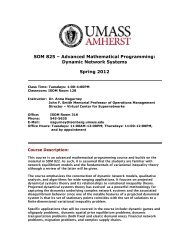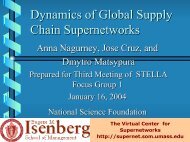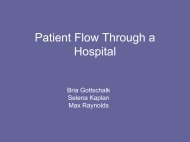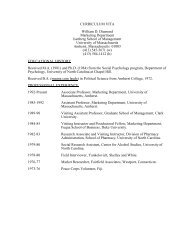NEWS BRIEFS(continued from page 33)percentage of underage drivers with an illegal BAChas decreased since 1973.Illegal drugs, as well as prescription and over-thecountermedications, were included in NHTSA’s 2007survey findings. According to the report, 16.3 percentof nighttime drivers had positive drug testresults—however, this does not necessarily indicateimpairment. The most commonly detected drugswere marijuana (8.6 percent of drivers), cocaine (3.9percent), and methamphetamine (1.3 percent).Additional research is needed to determine whichdrugs and dosage levels might impair driving.NHTSA is sponsoring a study to examine the linkbetween drug use and involvement in crashes; resultsare expected in 2012.INTERNATIONAL NEWSDetermining Crash Riskfor Older DriversAge is not the sole determining factor of driver capacity,according to a study recently released by VTI, theSwedish National Road and Transport <strong>Research</strong> Institute.Commissioned by the Norwegian Public RoadsAdministration (Statens Vegvesen) and conductedin collaboration with TØI, Norway’s Institute ofTransport Economics, the report compiled and analyzedpolice-reported accidents in Norway, a literaturestudy, and experimental studies in Norway andSweden to identify hazardous situations for driversage 65 and older and to examine visual behavior inthese situations.The VTI study found that the most frequent typeof accident among older drivers occurs when thedriver is making a left turn and is hit by anothervehicle on the right or left side. Rear-end collisions—the most frequent among all drivers—are less commonfor older drivers, according to the report.<strong>Research</strong>ers found that older drivers had proportionatelyfewer accidents than younger ones in situationsof inclement weather, poor visibility, orhazardous road conditions; this indicates that olderdrivers tend to avoid driving in these situations.The study also reconsidered the assumption thatadvanced age naturally implies risky driving behavior.According to researchers, driving risk in thesenior age group comes from two main causes—illnessand fatigue. As a group, older people had moreindividual differences in driving capacity thanyounger people; subsequent methods to determinecrash risk or unsuitable drivers must be refinedbeyond age groups, the study concluded.For more information, see www.vti.se/EPi-Browser/Publikationer/R656ASve.pdf.<strong>TR</strong> NEWS 264 SEPTEMBER–OCTOBER 200934Aviation Group SetsEnvironmental GoalsThe International Air Transport Association (IATA)has set three environment-friendly targets for theaviation industry: by 2020, a 25 percent improvementin fuel efficiency from 2005; a 10 percent useof alternative fuels by 2017; and a 50 percent reductionin aviation emissions by 2050. IATA is developinga fourth target—a “carbon-neutral growth” datebeyond which emissions will not increase, even withpopulation growth.According to IATA Director Giovanni Bisignani,aviation emissions will decline by 8 percent this year;although 6 percent of the drop is attributable to therecession, 2 percent is related to implementation ofIATA’s strategy, which incorporates technology, operations,infrastructure, and positive economic measuresto reduce aviation emissions.For more information, visit www.iata.org.Giovanni Bisignani, Director General and CEO ofIATA, opens the 65th IATA Annual General Meetingand World Air Transport Summit in Kuala Lumpur,Malaysia in June.
Integral and Semi-IntegralBridgesMartin P. Burke, Jr. Wiley–Blackwell,2009. 255 pp.; $139.99; 978-140519-418-1.This book traces the evolution ofdeck-type highway bridges fromthe early 1930s to the present,focusing on subjects of significance to the design andconstruction of integral and semi-integral bridges.Also examined are the uncontrolled growth–pressurephenomenon, the culprit of much bridge damage;the attributes and limitations of integral-typebridges to be considered in the design process; thestructure movement systems approach to highwaybridge design; and some of the problem-solving techniquesused by bridge design engineers. Real-life successstories and challenges—such as a bridgereplacement and rehabilitation project in Ohioinvolving more than 1,800 bridges—provide insight.Appendices to this volume include a critique ofa formerly published and incorrect set of concretepavement recommendations; a glossary to helpnovice engineers; and a collection of data anddescriptions pertaining to the integral and semiintegralbridges shown in photographs throughoutthe book. Author Burke is an emeritus member ofthe <strong>TR</strong>B General Structures Committee.Fragile Networks: Identifying Vulnerabilities andSynergies in an Uncertain WorldAnna Nagurney and Qiang (Patrick) Qiang. Wiley,2009. 313 pp.; $115; 978-0-470-44496-2.Using a mathematical, multivariate approach, thisbook endeavors to help policy makers, urban planners,and business strategists identify critical infrastructureinvestment needs to bolsterdisaster preparation and mitigation.Computer-based networksystems modeling and analysismethods are applied to vulnerabilitiesin congested urban transportationnetworks, logisticalnetworks, supply chains, theInternet, and other systems.The authors explore many network activities:the behavior of network users, demands forresources, resulting flows, and associated costs.Three sections address network fundamentals, efficiencymeasurement, and vulnerability analysis;applications and extensions; and network integration,mergers and acquisitions, and areas of cooperation.Potential areas for risk reduction anddisaster readiness are identified, along with possiblesynergies that can assist in disaster recovery.BOOKSHELFThe books in thissection are not <strong>TR</strong>Bpublications. To order,contact the publisherlisted.The Beginner’s Guide to Aviation BiofuelsAir Transport Action Group, May 2009. Available at www.enviro.aero/biofuels.To advance the use of biofuels in aircraft, the GenevabasedAir Trans port Action Group (ATAG)has publishedThe Beginner’s Guide to Aviation Biofuels. Unlikebiofuels derived from food crops such as rapeseed andcorn that are often unsuitable for use in aircraft, “second-generation”aviation biofuels are sustainably produced,meet performance and safety standards foraviation fuels, and are derived from nonfood crop sources that can be mass-grownin many geographic regions. Several airlines have successfully tested jet fuels fromalternative sources such as camelina, jatropha, and algae. The pamphlet examines thekey safety and technical criteria in the use of aviation biofuels, outlines the testingprocess currently under way, and looks at technical and sustainability challenges.<strong>TR</strong>B PUBLICATIONSHuman Performance: Infrastructure, InformationSystems, and Simulation<strong>Transportation</strong> <strong>Research</strong> Record 2069Authors study the effects of fog on car-following performance,run-off-the-road crashes involving overcorrection,the decision dilemma zone at a signalizedintersection approach, two-way stop-controlled intersectionson divided highways, left-turn warnings,auditory road safety alerts, wireless communicationand entertainment devices’ effects on driving, warningmessages and variable speed limits, right-turningvehicles and pedestrians approaching from the rightside, traveler information delivery mechanisms, andpretrip public transport information use.2008; 92 pp.; <strong>TR</strong>B affiliates, $40.50; nonaffiliates, $54.Subscriber category: safety and human performance (IVB).Concrete Materials<strong>Transportation</strong> <strong>Research</strong> Record 2070Presented are papers on internal curing, impactecho scanning for void detection in posttensionedconcrete, chloride permeability and microstructureof mortars incorporating nanomaterials, autoluminescentsurfaces for concrete pavements, propertiesof concrete containing vitreous calcium aluminosilicatepozzolan, modulus contrast betweennear-surface material and deeper material in concretepavements, the influence of curing conditionson strength development, and strategies for shrinkagemitigation.2008; 67 pp.; <strong>TR</strong>B affiliates, $37.50; nonaffiliates,$50. Subscriber category: materials and construction(IIIB).<strong>TR</strong> NEWS 264 SEPTEMBER–OCTOBER 200935


